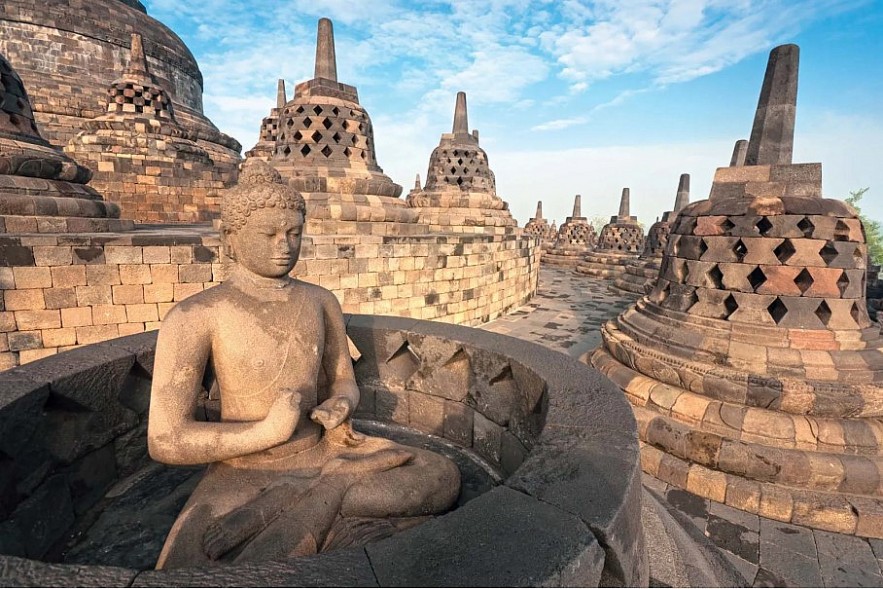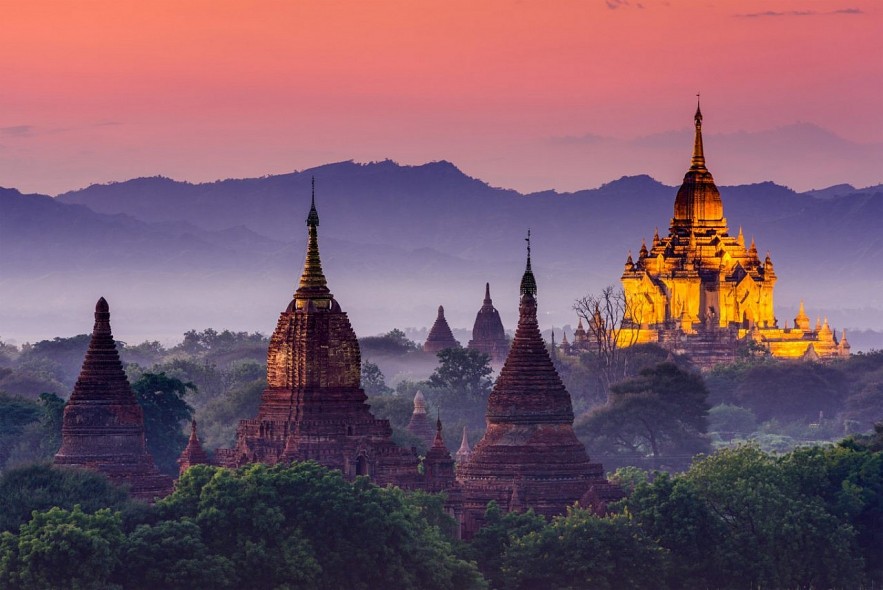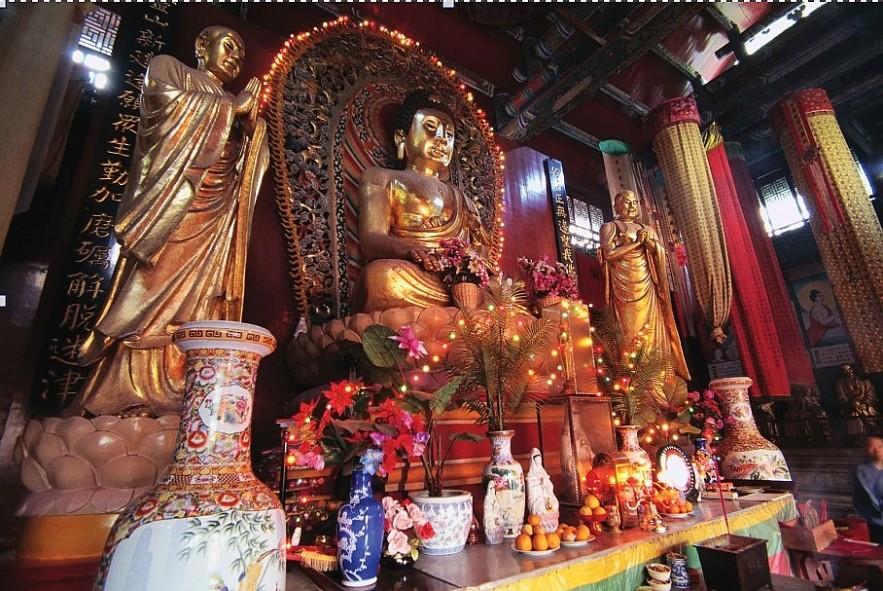 |
Despite being born in India, Buddhism found fertile ground in Southeast Asia, where it took root and flourished for centuries, shaping the region’s socio-economic, political, cultural, religious, and philosophical structures. This connection between Buddhism in South East Asia and India is a testament to the religion’s resilience and adaptability in the face of rapidly changing worlds and challenging circumstances over two millennia. The Buddhism in Southeast Asia from India underscores a complex interaction between different histories, cultures, and identities. Such a complex interaction involved multiple factors, including the influence of Indian merchants and traders, the patronage of Southeast Asian kings and rulers, and the work of Buddhist missionaries.
The arrival of Indian merchants and traders to Southeast Asia through sea routes from the 1st century CE onwards was a pivotal moment in the spread of Buddhism throughout the region. These travellers brought not only their wares, but also their rich cultural values, ethical principles, and religious traditions, including the teachings and philosophy of Buddhism. Consequently, the local populace of Southeast Asian countries began to adopt and embrace these values and practices, inaugurating a new era of spiritual and cultural exchange.
The spread of Buddhism is also owed to the patronage provided by rulers and power elites of the time. In particular, King Anawrahta of Burma and King Jayavarman-VII of the Angkor Empire embraced Buddhism and promoted its teachings, values, practices, and beliefs in their respective kingdoms. As a result, Buddhist practices and rituals became an integral part of court culture, permeating throughout the local population. To help establish Buddhism and spread its influence in the region, temples, monasteries, and other religious structures were built and scholarships were given to Buddhist monks and scholars. This ultimately led to the emergence of a unique form of Buddhism in Southeast Asia known as ‘State Buddhism’ or ‘Royal Buddhism’, in which the king was seen as the protector and promoter of the Buddhist faith. This intricate relationship between Buddhism and the State in Southeast Asia has become a defining feature of the region’s religious landscape, shaping its culture and society.
Buddhist monks, who embarked on arduous journeys to disseminate the principles and practices of Buddhism in a foreign land, and scholars from the Indian subcontinent played an instrumental role in bringing Buddhism to Southeast Asia. Their unwavering commitment and tireless efforts in spreading the message of Buddha were pivotal in the establishment of monasteries and temples in the region, which became epicenters of learning and spiritual enlightenment. The invaluable knowledge and teachings imparted by these venerable monks contributed to shaping the religious and cultural fabric of the area. In addition, the translations of Buddhist scriptures into local languages were a critical tool in propagating Buddhist teachings among the populace. This allowed for a wider dissemination of knowledge, and increased accessibility for those who were not proficient in the Pali language, which was the lingua franca of early Buddhist texts.
Fa-Hien, a remarkable Chinese traveller and Buddhist scholar, epitomizes the dedication and passion of these intrepid missionaries. His journey from India to Southeast Asia, in the pursuit of sharing the teachings of Buddhism, is a testament to the power of this religion and its capacity to motivate individuals to transcend geographical and cultural boundaries in pursuit of spiritual enlightenment. His travel account, ‘Record of Buddhist Kingdoms’, furthered the proliferation and spread of Buddhism in Southeast Asia.
Buddhism has evolved and adapted in various ways as it has spread throughout Asia. It has taken on new forms and interpretations, responding to the various cultural and social contexts in which it has found itself. One of the most prominent aspects of Buddhism in Southeast Asia has been its syncretic nature. This involves the incorporation of local customs and practices into the Buddhist faith, leading to the development of a unique blend of Buddhism and traditional religious practices. This is particularly evident in the nations of Thailand, Myanmar and Cambodia, where the Theravada form of Buddhism is widely practiced. This form of Buddhism emphasizes meditation and mindfulness, yet the local customs, rituals and folk traditions are equally entrenched in the society, reflecting the region’s rich and diverse culture.
Southeast Asian art, architecture, and literature have had an immense impact on Buddhism. As the religion spread and gained influence across the region, so too did the construction of monasteries, temples, and other religious and cultural sites. The architectural wonders of Angkor Wat in Cambodia, Borobudur in Indonesia, and Shwedagon Pagoda in Myanmar are testament to the intricate and grand Buddhist works. Buddhism also had a lasting impact on the literary culture of Southeast Asia, inspiring epics and other pieces of literature written in the local languages.
 |
Buddhism remains a powerful and enduring force in Southeast Asia, particularly in mainland countries like Myanmar, Laos, Cambodia, and Vietnam. Countless devotees engage in a myriad of Buddhist practices, making it an integral part of their daily lives and affairs. Even in insular nations like Malaysia and Indonesia, where the influence of Islamization is strong, Buddhist culture continues to thrive. Rich customs, traditions, and practices endure, with the Buddhist faith providing spiritual and cultural guidance to its followers.
The resilience of Buddhism in Southeast Asia is a testament to the persistent power of this ancient religion and its ability to adapt to changing times and contexts, while preserving its essential beauty and wisdom, derived from the tradition of ancient Indian subcontinent.
 |
The deep-rooted connection between Buddhism and Southeast Asia serves as evidence of the strong historical and cultural ties that bind India and the region together. The propagation of Buddhism from India to Southeast Asia not only facilitated the sharing of ideas, art, and values, but also established an everlasting civilizational bond that surpasses time and geographical boundaries. This common heritage serves as the basis for both regions to bolster and revitalize their commercial, religio-cultural, and people-to-people contact, fostering mutual understanding and collaboration in the modern age.
The resilience of Buddhism in Southeast Asia is a testament to its adaptability and ability to blend with the local customs, beliefs, and practices of the region, creating a unique fusion of diverse cultural elements. This combination of traditions has had a profound impact on the development of the unique identity of the region, informing its artistic, philosophical, and social milieu. As the world becomes ever more interconnected, the ancient link between Buddhism, India, and Southeast Asia reveals important lessons on the value of cultural diversity, intellectual exchange, and the promotion of tolerance and understanding between different groups. To ensure that this remarkable bond is not forgotten, it is essential to protect and celebrate it, as it can act as a driver for regional peace, progress, and harmony in the face of modern-day challenges.
By nurturing the rich and multifaceted relationship based on Buddhism, India, and Southeast Asia holds valuable lessons for the future and can serve as a catalyst for deeper, more meaningful collaborations and partnerships in all aspects of life. The potential for growth and development is enormous, by tapping into their rich heritage and fostering closer ties between the two regions, India and Southeast Asia can unlock new opportunities for growth, development, and prosperity. Whether in the fields of trade, commerce, or people-to-people contact, the shared history, spirituality and culture of these two regions can serve as a source of inspiration and innovation for generations to come. Let us work together towards a future marked by greater collaboration, cooperation, and respect for the unique identity and values of each community, paving the way for a brighter and more harmonious world.
Xiem Can Pagoda – the Khmer’s Splendid Architectural Work
Xiem Can Pagoda in the Mekong Delta province of Bac Lieu is a splendid architectural structure of the Khmer community and has long been a famous spiritual destination of the province.








